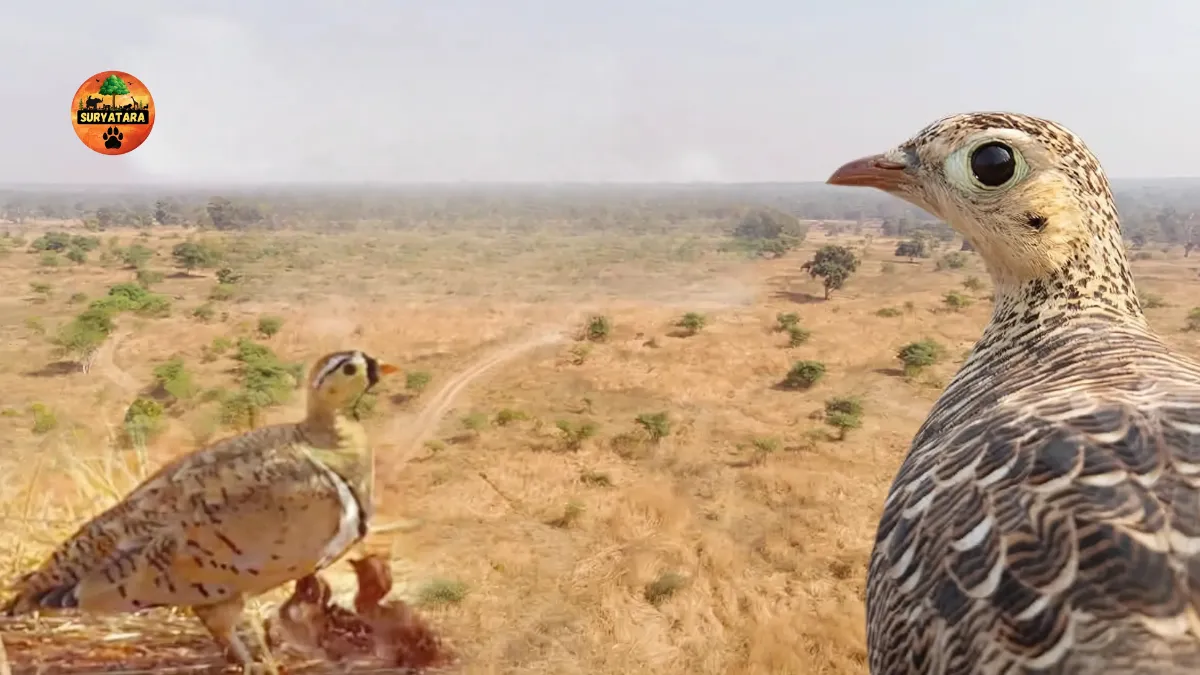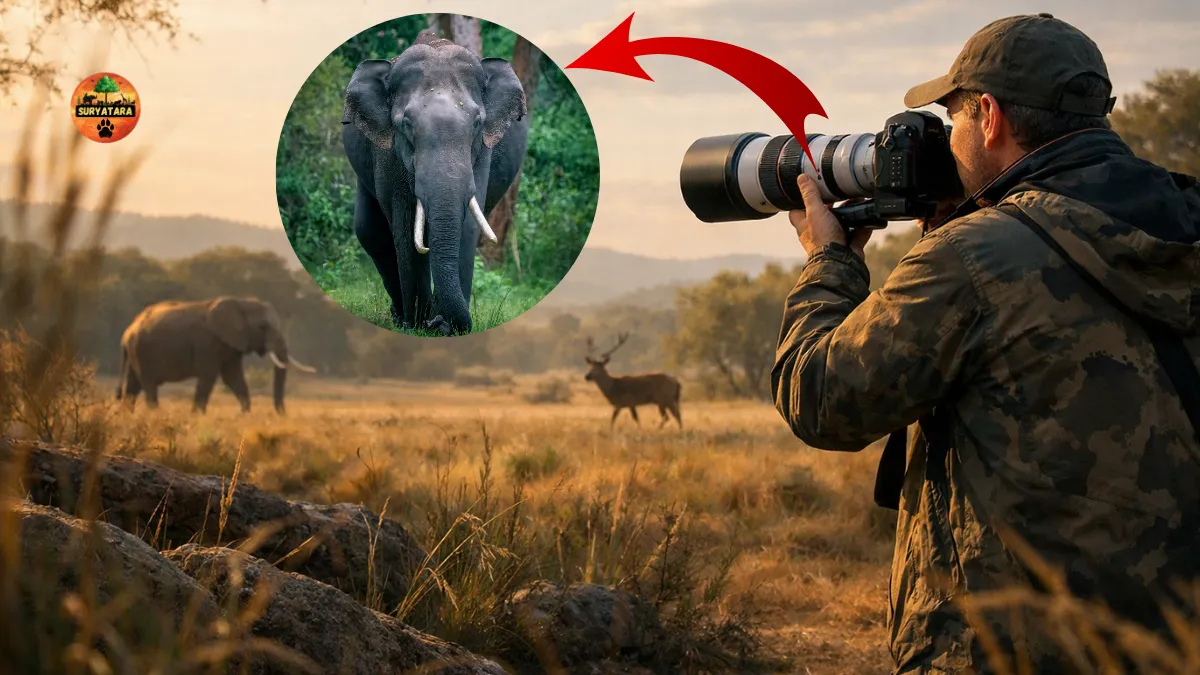Rare Sandgrouse Found in Nauradehi Tiger Reserve has become a fascinating story for wildlife lovers. The bird, often overlooked because of its pigeon-like appearance, has developed one of the most extraordinary survival techniques in the animal kingdom. Male sandgrouse carry water in their feathers across long distances to quench the thirst of their chicks in the dry and hot grasslands of central India. This rare behavior makes the sandgrouse not only unique but also one of the most caring parents in the bird world.
Nauradehi – The Land of Tigers, Cheetahs, and Rare Birds
Nauradehi Tiger Reserve, also known as Veerangana Rani Durgavati Tiger Reserve, is the largest tiger reserve in Madhya Pradesh. Spread over a vast area, it is widely known for its tiger conservation efforts and for being one of the future habitats of cheetahs in India. However, apart from big cats, the reserve is also home to many unique species of birds and animals. Among them, the rare sandgrouse stands out because of its unusual water-carrying behavior.
This region provides an ideal habitat for the sandgrouse due to its wide open grasslands, dry climate, and scattered bushes where these birds can nest safely. Interestingly, both the Sandgrouse and the Painted Sandgrouse are found in Nauradehi. The painted variety can be recognized by the striped patterns around its throat.
What Makes the Sandgrouse Special?
Sandgrouse are medium-sized birds that resemble pigeons in shape. They have long pointed wings and tails, which allow them to travel great distances in search of food and water. Typically found in deserts, barren lands, and open dry fields, they thrive in harsh climates where survival is not easy.
Their diet is mostly vegetarian – seeds, grains, pods, and grass shoots form their staple food. They also eat berries, green shoots, and occasionally legumes. But while food is relatively easy to find, water is their biggest challenge.
What makes them truly fascinating is the way they provide water to their chicks. In hot and dry habitats where water bodies are far apart, the male sandgrouse undertakes an incredible journey to bring water home.
The Water-Carrying Feathers
The male sandgrouse travels up to 30 to 40 miles every day to reach water sources. Once at the water body, it soaks its belly feathers in water. These feathers have a unique sponge-like structure that can trap and hold significant amounts of water. After ensuring that enough water has been absorbed, the bird takes off and flies all the way back to its chicks.
When the male reaches the nest, the chicks drink water directly from his wet feathers. They even peck and suck the moisture, while the father sometimes shakes droplets off his body to cool them down. This process not only quenches their thirst but also lowers their body temperature in the scorching heat.
This exceptional behavior has earned the sandgrouse the title of “Nature’s Water Tanker Bird.”
Sandgrouse in Nauradehi – A Rare Sight
Although sandgrouse are found in many parts of Africa, Madagascar, and the Middle East, their population in India is not very high due to shrinking habitats. Deforestation, agricultural expansion, and climate change have reduced their natural living spaces.
That is why the sighting of rare sandgrouse in Nauradehi Tiger Reserve is significant. Experts believe that the wide grasslands and relatively undisturbed environment of Nauradehi make it one of the few safe zones for these birds in central India.
According to Dr. A.A. Ansari, Deputy Director of Nauradehi Tiger Reserve, “Since this is a dry region, terrestrial birds like sandgrouse have developed special techniques for survival. The way they soak water in their feathers and deliver it to chicks is a fascinating example of nature’s intelligence.”
Painted Sandgrouse – Another Feathered Resident
Alongside the rare sandgrouse, Nauradehi is also home to the Painted Sandgrouse, which is slightly different in appearance. The painted variety is known for the striped markings on its throat and chest. Both species build nests close to bushes or shrubs for better safety. They remain extremely cautious and alert while protecting their chicks from predators.
Diet and Feeding Habits
Sandgrouse are strict vegetarians. Unlike many birds, they do not hunt insects or worms. Instead, they depend mainly on seeds, grains, and pods from legumes. In the wild grasslands of Nauradehi, they find plenty of grass seeds and crop residues that support their diet.
Here’s a quick look at their food habits:
| Food Source | Details |
|---|---|
| Seeds & Grains | Main diet, including cereal grains and wild seeds |
| Legume Pods | Preferred food, as they are protein-rich |
| Grass Shoots & Stems | Commonly consumed in dry fields |
| Berries & Fruits | Occasionally eaten, especially during the rainy season |
| Green Leaves & Twigs | Provide moisture and nutrition in the absence of water |
Survival Challenges
Despite their remarkable water-carrying ability, sandgrouse face multiple threats:
- Habitat Loss: Expansion of agriculture and urbanization reduce their grassland habitats.
- Water Scarcity: Drying water bodies force them to fly longer distances, making survival harder.
- Predators: Eggs and chicks are vulnerable to snakes, foxes, and birds of prey.
- Climate Change: Rising temperatures increase stress on their water-fetching behavior.
Conservation of open grasslands like Nauradehi is therefore crucial for their long-term survival.
Also read: Top Endangered Species in the World and Their Survival Challenges
Why the Rare Sandgrouse Found in Nauradehi Matters
The discovery and regular sighting of rare sandgrouse in Nauradehi Tiger Reserve is more than just a birdwatching delight. It highlights the importance of protecting grassland ecosystems in India. While big cats like tigers and cheetahs often dominate headlines, smaller species like the sandgrouse are equally important in maintaining ecological balance.
Their unique adaptation of carrying water in feathers is not only a marvel of evolution but also a powerful reminder of how nature designs survival strategies for the harshest environments.
Also read: Tiger Safari in Betla: 2027 तक झारखंड को मिलेगा नया वन्यजीव आकर्षण”
Conclusion
The story of the Rare Sandgrouse Found in Nauradehi is a tale of resilience, adaptation, and parental care. This pigeon-like bird may not be as famous as the tiger or the cheetah, but its ability to act as a water carrier for its chicks is nothing short of miraculous.
As conservation efforts continue in Nauradehi, protecting both predators and prey, it is essential to ensure that rare birds like the sandgrouse also receive attention. After all, the survival of such unique species enriches our understanding of wildlife and reminds us of the incredible intelligence hidden in nature’s design.











